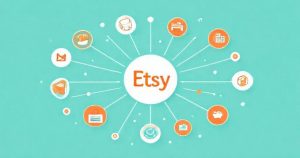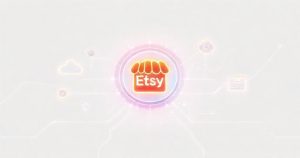In the vibrant world of online selling, particularly on platforms like Etsy, efficiency and connectivity are paramount for success. Etsy integrations refer to third-party applications and services that connect directly with your Etsy shop, automating various aspects of your business. These powerful tools are designed to streamline operations, enhance productivity, and ultimately help sellers scale their creative ventures. Understanding the diverse range of available integrations and how they can benefit your specific business model is a critical step for any ambitious Etsy shop owner looking to optimize their workflow and expand their reach in the digital marketplace.
Understanding Etsy Integrations: Streamlining Your Creative Business
Etsy integrations serve as a bridge between your Etsy shop and other essential business tools, creating a cohesive and automated operational environment. Instead of manually transferring data between different platforms, these integrations facilitate seamless communication, allowing information to flow freely and accurately. This connectivity covers a broad spectrum of functionalities, from managing inventory and processing orders to handling shipping, accounting, and even marketing efforts. For many independent sellers, effective Etsy integrations can transform a time-consuming hobby into a well-oiled, profitable business, freeing up valuable time to focus on creation.
What Are Etsy Integrations?
Etsy integrations encompass a wide array of software solutions designed to extend the capabilities of your Etsy shop. They range from simple plug-ins to comprehensive enterprise resource planning (ERP) systems, all built to interact with Etsy’s application programming interface (API). The primary goal of these connections is to eliminate redundant tasks, reduce human error, and provide a unified view of your business operations. By leveraging these tools, sellers can automate routine processes, ensuring that vital information, such as stock levels or order statuses, is always current across all integrated platforms, enhancing overall operational efficiency.
Why Integrate Your Etsy Shop for Enhanced Productivity?
Integrating your Etsy shop brings numerous advantages, significantly boosting productivity and overall business performance. One major benefit is the substantial time savings achieved by automating repetitive tasks, allowing sellers to dedicate more energy to product development and customer engagement. Furthermore, these integrations help minimize errors that can arise from manual data entry, ensuring accuracy in inventory counts, shipping addresses, and financial records. Ultimately, well-chosen Etsy integrations empower sellers to manage their growing businesses with greater ease and precision, leading to a more professional and sustainable operation in the long run.
Essential Categories of Etsy Integrations for Sellers
The landscape of Etsy integrations is vast, offering specialized tools tailored to address distinct business needs. Categorizing these integrations helps sellers identify the most relevant solutions for their specific operational challenges and growth objectives. From managing product stock across multiple channels to simplifying the complexities of financial reporting, each category plays a crucial role in creating a more efficient and interconnected e-commerce ecosystem. Understanding these core categories is the first step towards building a robust and integrated business framework that supports sustained growth and profitability.
Inventory and Order Management Systems for Etsy
Effective inventory and order management systems are foundational for any successful Etsy shop, especially as order volumes increase or if you sell across multiple platforms. These integrations automatically update stock levels on Etsy whenever a sale occurs elsewhere or when new inventory is added. They also centralize order processing, allowing sellers to view, manage, and fulfill all orders from a single dashboard. This synchronization prevents overselling, reduces manual tracking, and ensures that customers receive accurate information regarding product availability, significantly improving the overall customer experience and operational accuracy for Etsy sellers.
Shipping and Fulfillment Solutions Integrated with Etsy
Streamlining the shipping process is crucial for customer satisfaction and operational efficiency. Shipping and fulfillment integrations connect directly with your Etsy shop to automate label generation, calculate shipping costs, and provide real-time tracking updates. Many of these solutions also offer discounted shipping rates and allow for bulk label printing, saving both time and money. By integrating these tools, Etsy sellers can significantly reduce the manual effort involved in preparing orders for shipment, ensuring faster and more reliable delivery services, which is a key factor in building customer loyalty and positive reviews.
Accounting and Financial Tools for Etsy Shop Owners
Managing finances accurately is vital for understanding your Etsy shop’s profitability and fulfilling tax obligations. Accounting integrations automatically import sales data, expenses, and transaction fees directly from Etsy into your chosen accounting software. This automation eliminates the need for manual data entry, reducing the potential for errors and saving considerable time during tax season or when preparing financial reports. These integrations provide a clear, real-time overview of your shop’s financial health, empowering Etsy sellers to make informed business decisions based on accurate and up-to-date financial data.
Marketing and Customer Relationship Management (CRM) for Etsy
Building strong customer relationships and effective marketing strategies are essential for sustained growth. Marketing and CRM integrations help Etsy sellers connect with their audience beyond the platform. These tools can automate email marketing campaigns, manage customer communications, segment customer lists, and even integrate with social media scheduling. By centralizing customer data and automating outreach, sellers can foster stronger connections, encourage repeat purchases, and expand their brand’s visibility. Strategic use of these Etsy integrations can significantly enhance your marketing efforts and cultivate a loyal customer base.
How to Select the Optimal Etsy Integrations for Your Shop
Choosing the right Etsy integrations requires careful consideration of your business’s unique needs and long-term goals. A haphazard approach can lead to inefficiencies or unnecessary expenses. Instead, a methodical evaluation process ensures that the selected tools genuinely contribute to improving your operations and supporting your growth trajectory. Focusing on practical benefits, compatibility, and future scalability will guide you toward making informed decisions that yield the best return on investment for your Etsy shop and overall e-commerce strategy.
Assessing Current Business Workflow and Needs for Etsy
Before exploring specific Etsy integrations, it is essential to conduct a thorough assessment of your current business workflow. Identify your most time-consuming tasks, recurring pain points, and areas prone to errors. Are you struggling with manual inventory updates, slow shipping processes, or complex financial reconciliation? Pinpointing these specific challenges will help you prioritize which types of integrations will offer the most immediate and significant improvements. A clear understanding of your operational gaps is the foundation for selecting tools that genuinely address your business requirements.
Evaluating Compatibility and Feature Sets of Etsy Integrations
Once your needs are identified, the next step is to evaluate potential Etsy integrations based on their compatibility and feature sets. Ensure that any chosen solution seamlessly integrates with Etsy and your other existing platforms. Look for features that directly address your pain points, offering robust functionality without unnecessary complexity. Compare different options, paying attention to user reviews, documentation, and ease of setup. A comprehensive feature comparison will help you determine which integration provides the best fit for your specific operational requirements and technical comfort level.
Considering Scalability and Support for Long-Term Etsy Growth
As your Etsy shop grows, your integration needs may evolve. Therefore, it is crucial to consider the scalability of any chosen solution. Will the integration be able to handle increased order volumes, expanded product lines, or additional sales channels without requiring a complete overhaul? Additionally, evaluate the quality of customer support offered by the integration provider. Reliable support is invaluable when encountering technical issues or needing assistance with new features. Prioritizing scalable and well-supported Etsy integrations ensures that your technology infrastructure can adapt and continue to serve your business effectively over time.
Implementing Integrations to Maximize Etsy Shop Potential
Strategic implementation of Etsy integrations is not merely about adopting new software; it is about leveraging these tools to unlock new levels of efficiency, expand market reach, and gain deeper insights into your business performance. When properly integrated, these solutions work synergistically to create a powerful ecosystem that supports growth and allows you to focus on your core creative strengths. The goal is to transform your operational challenges into opportunities for streamlined success and competitive advantage within the bustling Etsy marketplace.
Enhancing Operational Efficiency and Time Savings with Etsy Integrations
The most immediate benefit of implementing Etsy integrations is the dramatic improvement in operational efficiency and the significant time savings achieved. Automation of tasks like inventory synchronization, order processing, and shipping label generation frees up countless hours that would otherwise be spent on manual data entry and administrative work. This efficiency allows Etsy sellers to reallocate their valuable time to creative pursuits, product development, marketing initiatives, or customer service. By minimizing repetitive tasks, integrations empower sellers to run a smoother, more responsive, and less labor-intensive business operation.
Expanding Market Reach and Diversifying Sales Channels via Etsy Integrations
Etsy integrations offer powerful capabilities for expanding your market reach beyond the Etsy platform. Many tools allow for seamless synchronization of product listings and inventory across various e-commerce platforms, such as your own independent website or other marketplaces. This multi-channel selling approach helps diversify your sales channels, reduces reliance on a single platform, and exposes your products to a broader audience. Strategic Etsy integrations enable sellers to manage a complex multi-channel presence from a centralized system, making growth and market diversification more accessible and manageable.
Gaining Deeper Insights Through Data Synchronization with Etsy
Data is a powerful asset for any business, and Etsy integrations excel at providing comprehensive data synchronization across your various tools. By consolidating information from sales, inventory, shipping, and accounting, sellers gain a holistic view of their business performance. This integrated data allows for more accurate reporting, better trend analysis, and informed decision-making regarding product offerings, pricing strategies, and marketing campaigns. Leveraging these insights helps Etsy shop owners understand customer behavior and market demand, leading to more targeted and effective business strategies for sustained growth.
Overcoming Common Hurdles in Etsy Integration Journeys
While Etsy integrations offer immense benefits, the journey to a fully optimized integrated system can present certain challenges. Understanding these common hurdles and knowing how to address them is crucial for a smooth transition and successful long-term implementation. Proactive planning, thorough research, and a willingness to adapt can help mitigate potential issues, ensuring that the benefits of integration outweigh any initial difficulties. Addressing these concerns directly contributes to maximizing the return on investment from your chosen Etsy integration solutions.
Addressing Data Discrepancies and Synchronization Challenges in Etsy
One of the most common challenges encountered with Etsy integrations involves data discrepancies and synchronization issues. Occasionally, information may not update correctly between platforms, leading to incorrect inventory counts, shipping errors, or financial mismatches. To mitigate this, regularly monitor your integrated systems and conduct periodic audits of key data points. Choose integrations known for their robust synchronization capabilities and reliable performance. Understanding the integration’s update frequency and troubleshooting guides can help quickly resolve any inconsistencies, ensuring data integrity across your entire business ecosystem.
Navigating Setup Complexity and Learning Curves for Etsy Integrations
Setting up new Etsy integrations can sometimes be complex, involving technical configurations and a learning curve for new interfaces. Many sellers, especially those new to e-commerce tools, may feel overwhelmed by the initial setup process. To overcome this, prioritize integrations with intuitive user interfaces and comprehensive support documentation. Take advantage of free trials, tutorials, and customer support resources offered by the integration provider. Investing time in understanding how to effectively use the tools will pay dividends in long-term efficiency, transforming initial complexity into seamless operational benefits for your Etsy shop.
Weighing the Costs and Benefits of Integrated Etsy Solutions
The financial aspect of Etsy integrations is a significant consideration, as many solutions come with subscription fees. It is crucial to conduct a thorough cost-benefit analysis before committing to any integration. Evaluate whether the time savings, error reduction, and growth opportunities provided by the integration justify its cost. Consider the potential increase in profitability through enhanced efficiency and expanded market reach. While some integrations may require an initial investment, the long-term gains in productivity and business scalability often far outweigh the expense, making them strategic investments for your Etsy business.
Conclusion: The Strategic Advantage of Etsy Integrations
Etsy integrations represent a powerful strategic advantage for any seller looking to optimize their online business. By automating crucial tasks, centralizing data, and connecting various operational aspects, these tools free up valuable time and resources, allowing for greater focus on creativity and growth. From streamlined inventory and order management to enhanced marketing and accurate financial tracking, the right integrations can transform a bustling Etsy shop into a highly efficient and scalable enterprise. Embracing these technological solutions is not merely about convenience; it is about building a robust, adaptable, and profitable foundation for sustained success in the competitive e-commerce landscape.





